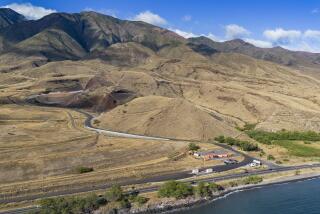Chatham Dump Cleanup Testing to Begin Monday : Escondido Crosses Fingers, Awaits End of Toxic-Waste Site
After nearly a decade of studies and debate, cleanup will begin Monday at Escondidoâs Chatham Brothers Barrel Yard, one of the stateâs worst toxic-waste dumps.
Jim Marxen, spokesman for the state Department of Health Services, said Thursday that cleanup crews in protective âmoon suitsâ will begin removing brush, weeds and trees from the site Monday to prepare for soil, underground water and air testing.
A $1-million fund reserved for the Chatham cleanup will cover costs of the required tests and the actual cleanup, which is slated to begin in mid-December and be completed by mid-January, 1990, Marxen said. He said that, if the soil, water and air testing turn up more areas of toxic contamination, the project will have to be broadened and more funds found for cleanup.
Holding Their Breath
City and county officials expressed âwait-and-seeâ attitudes about the cleanup start. Diane Takvorian of the Environmental Health Coalition said contractors started a similar cleanup in 1987 without removing any of the toxic materials from the dump site.
âTwo years ago they put on moon suits and dug inventory wellsâ to determine the extent of ground water contamination, Takvorian said, âbut the efforts ended there.â
âOf course, I am very happy that there is some activity on the site, but I want to see the health and safety plan and a schedule for the actual cleanup,â Takvorian said.
The barrel yard, in a residential area of southwest Escondido, began operation in the early 1940s as a solvent recycling operation, oil drum storage area and hazardous-waste trucking yard. The operation was closed in the late 1970s and placed on the stateâs toxic-waste site cleanup list in 1981.
Preliminary tests indicate that more than 200 barrels above ground, several large underground tanks and sludge on the 5.4-acre site contain petroleum distillates, PCBs, heavy metals and other contaminants.
âItâs been a long time coming, and Iâm not sure itâs here,â Escondido Councilwoman Carla DeDominicis said Thursday. She said she had not been notified of the cleanupâs start and will be in Washington on city business Monday.
Last December, DeDominicis and other Escondido council members endorsed a county Board of Supervisorsâ move to speed the state cleanup effort, which has moved at a snailâs pace during the 1980s and threatened to halt when it was determined that incinerating the toxic waste might increase cleanup costs from $14 million to $20 million.
Proposals by the county Division of Environmental Health Services to use alternate disposal methods costing less than 10% of incineration were finally accepted by state and federal toxic-waste authorities, and the project got back on track earlier this year.
Gary Stephany, county environmental health services director, said his staff was notified Thursday of Mondayâs cleanup start but had not been asked to participate.
Stephany said he would be glad to offer the countyâs services if requested, adding that the county could âprobably do the job more quickly and a lot more cheaply.â
Some Still Skeptical
Escondido Councilman Kris Murphy acknowledged that he is still skeptical about the stateâs plans to complete the cleanup. âYou never know when they are going to run out of money as they did before or find something that they hadnât expected,â he said. âI think we should have a block party to celebrate, but not until the work is completed.â
Councilman Ernie Cowan, who had said he expected the cleanup to be accomplished âwhen hell freezes over,â said Thursday: âAre you telling me that hell has frozen over? Iâll wait and see.â
Marxen said, however, that the cleanup will progress, slowly but surely, to its conclusion.
Crews will begin clearing and grubbing the site Monday. Fencing around the toxic hot spot will be extended to include property to the north, where ground contamination has been found. Trailers will be placed on the site to serve as a testing laboratory, he said.
In coming months, test wells will be drilled around the perimeter of the dump site to determine if underground water flows have been contaminated, Marxen said. âBut we will be very surprised to find any migration of the contamination off the siteâ to the southeast, he said, where water drains into a swale and eventually reaches Lake Hodges, a San Diego city reservoir. Earlier tests showed no signs of underground water contamination off-site, he said.
Marxen said the above-ground barrels now visible on the site might be removed earlier than the mid-December waste-removal date, but that no schedule had been set.
After the testing, a health assessment report will be prepared, and a public meeting will be held in October before any toxic materials are removed, Marxen said.
The state health department spokesman also said a public hearing will be held April 10 at Escondido City Hall to inform the community about what will be occurring in coming months.
More to Read
Sign up for Essential California
The most important California stories and recommendations in your inbox every morning.
You may occasionally receive promotional content from the Los Angeles Times.










